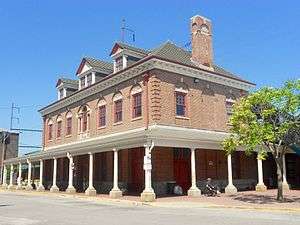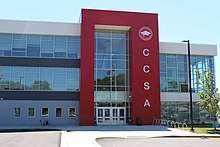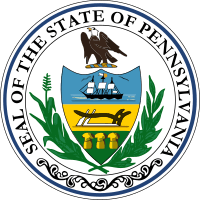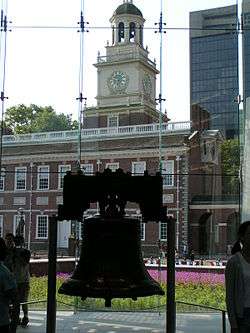Chester, Pennsylvania
Chester is a city in Delaware County, Pennsylvania, United States. With a population of 33,972 at the 2010 census it is the largest city in Delaware County.[4] Incorporated in 1682, Chester is the oldest city in Pennsylvania[5] and is located on the western bank of the Delaware River between the cities of Philadelphia and Wilmington, Delaware.
Chester, Pennsylvania | |
|---|---|
Downtown Chester at 5th and Avenue of the States | |
 Location in Delaware County and the U.S. state of Pennsylvania | |
 Chester Location of Chester in Pennsylvania  Chester Chester (the United States) | |
| Coordinates: 39°50′50″N 75°22′22″W | |
| Country | United States |
| State | Pennsylvania |
| County | Delaware |
| Founded | 1682 |
| Government | |
| • Mayor | Thaddeus Kirkland |
| Area | |
| • Total | 6.00 sq mi (15.55 km2) |
| • Land | 4.83 sq mi (12.52 km2) |
| • Water | 1.17 sq mi (3.04 km2) |
| Elevation | 69 ft (21 m) |
| Population (2010) | |
| • Total | 33,972 |
| • Estimate (2019)[2] | 34,000 |
| • Density | 7,034.97/sq mi (2,716.00/km2) |
| Time zone | UTC-5 (EST) |
| • Summer (DST) | UTC-4 (EDT) |
| ZIP code | 19013 |
| Area code(s) | 484, 610 |
| FIPS code | 42-045-13208 |
| FIPS code | 42-13208 |
| GNIS feature ID | 1171694 |
| Website | www |
| Designated | October 13, 1947[3] |
History
Early history
The Indian tribe that owned the land where Chester now stands were the Okehockings, removed by order of William Penn in 1702 to other lands in Chester County.[6] The original Indian name of Chester was Mecoponaca.[7]
The first European settlers in the area were members of the New Sweden colony. The settlement that became Chester was first called "Finlandia" (the Latin name for Finland) and then "Upland" after the Swedish province of Uppland. The New Sweden settlers built Fort Mecoponacka in 1641 to defend the settlement.[8]
In 1644, the present site of Chester was a tobacco plantation operated by the New Sweden colonists.[9]
By 1682, Upland was the most populous town of the new Province of Pennsylvania. On October 27, the ship Welcome arrived bearing William Penn on his first visit to the province. Penn renamed the settlement after the English city of Chester.[10]
18th century
Chester County originally stretched from the Delaware River to the Susquehanna River from its founding in 1682 until 1729 when Lancaster County was formed from the western part.[11] Chester served as the county seat for Chester County from 1682 to 1788.[12] In 1724, the Chester Courthouse was built to support the legal needs of the county.[13]
Chester played only a small role in the American Revolutionary War. Throughout 1776 and 1777, there were significant forces stationed in Chester and nearby Marcus Hook.
In April 1776, nearly 1,000 men were stationed in Chester under Colonel Samuel Miles in preparation for the defense of Philadelphia. However, Colonel Miles led the troops to New York City in July 1776 when it became clear that the British Fleet was threatening New York rather than Philadelphia.[14]
In 1777, the Continental Army led by George Washington passed through Chester on the way to meet the British Army led by General Howe at the Battle of Brandywine. John Armstrong was ordered to take command of the militia stationed at Chester. The Continental Army fled back to Chester after defeat at the Battle of Brandywine. A portion of the British force occupied Chester as they chased the Continental Army fleeing to Philadelphia.[15]
In 1788, the Chester County seat was moved from Chester to West Chester.[12] In 1789, Delaware County was formed from the eastern part of Chester County, and Chester became the new county seat.[16]
On March 5, 1795, the borough of Chester, which had been governed under the charter granted by Penn in 1701 was incorporated by the Pennsylvania Assembly.[17]
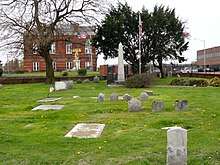
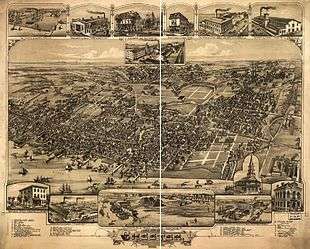
19th century
In the 1700s and 1800s, Chester was a hub for business due to easy access to the Delaware River for the transport of raw materials and finished goods by ship.
By the mid-1800s, many textile mills and factories were built along Chester Creek including the Upland Mills by John Price Crozer[18] and the Powhattan Mills by David Reese Esrey and Hugh Shaw.[19]
During the War of 1812, a group of volunteers from Chester called the Mifflin Guards was raised and led by Dr. Samuel Anderson. The troops were sent to Fort DuPont to defend the Delaware River from the threatened attack of British Admiral George Cockburn but did not see any action.[20]
In 1851, the Delaware County seat was moved from Chester to the borough of Media.[21] On February 14, 1866, Chester was incorporated as a city[22] and the first mayor elected was John Larkin, Jr..
In 1871, the Delaware River Iron Ship Building and Engine Works was opened by John Roach through the purchase of the Reaney, Son & Archbold shipyard. The first steel ships of the U.S. Navy were built at the Roach shipyard.[23] For the first 15 years of operation, it was the largest and most productive shipyard in the United States. More tonnage of ships were built at the Roach shipyard than its next two competitors combined.
Roach built other businesses to supply materials for his shipbuilding including the Chester Rolling Mill in 1873 to supply metal hull plates and beams, the Chester Pipe and Tube Company in 1877 for the manufacture of iron pipes and boiler tubes, and the Standard Steel Casting Company in 1883 to supply steel ingots.
Roach built the Combination Steel and Iron Company in 1880 to supply steel rails and other products for businesses beyond the Roach shipyard. He lost control of the company after his shipbuilding enterprise entered receivership in 1885.
First half of the 20th century
World War I brought Chester its first massive growth. People migrated to Chester for jobs, 63% of which were in manufacturing.[24] Between 1910 and 1920, Chester's population increased from 38,000 to 58,000 due to the influx of southern and eastern Europeans and southern U.S. blacks.[25] The Sun Shipbuilding & Drydock Co. was opened in 1917 to build ships for the United States until its closure in 1990. The idled Roach shipyard was purchased in 1917 by W. Averell Harriman to build merchant ships during World War I, and renamed the Merchant Shipbuilding Corporation. The shipyard closed permanently in 1923.
Like many boomtowns, Chester was unprepared for the social changes that came along with rapid growth. As southern blacks migrated to Pennsylvania as part of the Great Migration, racial violence broke out, racially segregated neighborhoods expanded and economic discrimination emerged.[26] A four-day race riot that resulted in seven deaths broke out in the city in July 1917, and the separation of blacks and whites in Chester's neighborhoods and workplaces became more defined.[27]
Chester was known as a freewheeling destination for vices such as drugs, alcohol, numbers rackets, gambling and prostitution. Chester was widely known as Greater Philadelphia's "Saloon Town".[28] By 1914, Chester had more saloons than police officers; approximately 1 saloon per every 987 residents.[29]
In 1927, the Ford Motor Company opened the Chester Assembly factory on the site of the previous Roach and Merchant shipyard and built cars there until its closure in 1961.[30]
Chester experienced its second growth period during World War II. Manufacturing increased exponentially including companies such as Wetherill Steel and Boilermakers, Congoleum-Nairn, Aberfoyles Textiles, Scott Paper Company, Belmont Iron Works, American Steel Foundries, Crew Levick Oil, Crown Smelting, Fields Brick Company, Hetzel and Ford Motor Company.[24] During World War II, the Sun shipyard became the largest single shipyard in the world.[31]
The increased labor needs brought a flood of new workers to the city. The wartime labor force for industries along the waterfront soared to 100,000.[31]
Second half of the 20th century
Chester began losing its mainstay manufacturing jobs by the early 1960s. Ford Motor Company shuttered its Chester plant, American Viscose Corporation in nearby Marcus Hook closed, Baldwin Locomotive Works in nearby Eddystone was close to bankruptcy and Sun Shipyard employment had fallen from a high of 35,000 in 1945 to 4,000. The precipitous drop in jobs in Chester caused the population to be halved from over 66,000 in 1950 to under 34,000 in 2010.[33]
Chester school protests
The Chester school protests were a series of demonstrations that occurred in Chester from November 1963 through April 1964. The demonstrations focused on ending the de facto segregation that resulted in the racial categorization of Chester public schools, even after the landmark U.S. Supreme Court case Brown v. Board of Education (1954).[34] The racial unrest and civil rights protests led by George Raymond of the National Association for the Advancement of Colored Persons (NAACP) and Stanley Branche of the Committee for Freedom Now (CFFN) made Chester one of the key battlegrounds of the civil rights movement.
In April 1964, a series of almost nightly protests brought chaos to Chester. The mayor James Gorbey, issued "The Police Position to Preserve the Public Peace", a 10-point statement promising an immediate return to law and order. The city deputized firemen and trash collectors to help handle demonstrators.[35] The State of Pennsylvania deployed 50 state troopers to assist the 77-member Chester police force.[36] The demonstrations were marked by violence and police brutality[37] with Chester being dubbed the "Birmingham of the North" by James Farmer.[36] Over 600 people were arrested over a two-month period of civil rights rallies, marches, pickets, boycotts and sit-ins.[38] National civil rights leaders such as Gloria Richardson, Malcolm X and Dick Gregory came to Chester in support of the demonstrations.[39] Pennsylvania Governor William Scranton became involved in the negotiations and convinced the protestors to obey a court-ordered moratorium on demonstrations by agreeing to hold hearings on the de facto segregation of public schools in Chester.[33]
The Pennsylvania Human Relations Committee determined that the Chester School Board had violated the law and the Chester School District was ordered to desegregate the city's six predominantly African-American schools. The city appealed the ruling, which delayed implementation however the schools were eventually desegregated.[36]
Wade Dump Fire
In 1978, an intense fire broke out at Wade Dump, a rubber recycling facility and illegal industrial chemical dumping site, and burned out of control for several days. The burning chemicals caused multi-colored smoke and noxious fumes which injured 43 firemen and caused long-term health problems for the first responders to the fire.[40] In 1981, the location was declared a Superfund cleanup site and remediation occurred throughout the 1980s. In 1989, the site was deemed safe and removed from the Superfund national priorities list. In 2004, the site was converted to a parking lot for the nearby Barry Bridge Park.[41]
By the 1980s, Chester was a city bereft of industry. Many bottom-rung projects were initiated in Chester, including the Westinghouse trash incinerator, a sewage treatment plant and a prison.[42] Chester residents and politicians began pushing back against the placement of projects that increased concerns about pollution, noise and trucks such as a contaminated soil remediation facility, the trash incinerator, the DELCORA sewage waste treatment center and the Abbonizio recycling center.[43]
In 1995, the state designated Chester as a financially distressed municipality.[44]
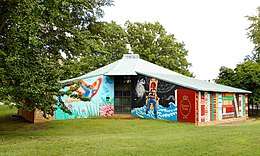
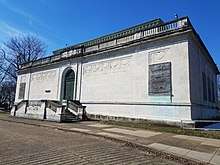
21st century
Recent programs to foster investment into Chester include the Pennsylvania Keystone Opportunity Zone (KOZ) program, which incentivizes companies with state and local tax breaks to invest in KOZ-designated areas. The Wharf at Rivertown, a $60 million renovation of the Chester Waterside Station of the Philadelphia Electric Company, originally built in 1918, was renovated and provides recreational and office space for businesses.[45]
Harrah's Casino and Racetrack began harness racing in September 2006, and opened its racino in January 2007. Subaru Park, home of the Major Soccer League Philadelphia Union franchise, opened in 2010.[42]
Two ships of the United States Navy have been named USS Chester in honor of the city.
The following are listed on the National Register of Historic Places: Delaware County National Bank, 1724 Chester Courthouse, Chester Waterside Station of the Philadelphia Electric Company, Old Main and Chemistry Building, Third Presbyterian Church, William Penn Landing Site, and the former Second Street Bridge.[46]
Government
Chester has a mayor-council government system, consisting of a popularly elected city mayor and city council. The terms of the mayor and members are four years.[47]
The current mayor of the City of Chester is Thaddeus Kirkland, who won the Democratic nomination in May 2015 over incumbent Mayor John Linder. Kirkland was elected on November 3, 2015, and took office on January 4, 2016.[48][49]
The Chester City Council consists of the mayor and four council members. Council members are elected at-large to serve the entire city. Council meetings are generally held the second and fourth Wednesday of each month. The five help administer the five municipal departments:[50]
- The Department of Public Affairs
- The Department of Public Safety
- The Department of Public Works
- The Parks and Recreation Department
- The Finance and Tax Office
The city government has been in financial distress for many years and has operated under the state's Act 47 provisions for twenty-one years. The act provides for municipalities that are near bankruptcy.[51]
Political corruption
Chester has been negatively impacted for decades by corrupt politicians and organized crime.[52] Chester's Republican Party political machine was one of the nation's oldest and most corrupt.[53] John J. McClure took over from his father, William McClure, in 1907[53] and was the political boss for the machine until his death in 1965. In 1933, McClure was found guilty in federal court and sentenced to 18 months in prison for vice and rum-running[54] but his conviction was overturned on appeal.[55]
In 1941, McClure was indicted for conspiracy to gain a $250,000 profit from the sale of the Chester Water Works to a private buyer. McClure and four Chester City Council members were acquitted but ordered by the court to return the money to the city of Chester.[56]
With the exception of 1904–1905, the Republican political machine controlled Chester politics for over a century. A non-machine mayor was not elected until 1992[28] with the election of Barbara Bohannan-Sheppard.
In the 1990s, the Pennsylvania Crime Commission reported that Chester's government had been dominated by "a triad of criminals, corrupt politicians and rogue law-enforcement officers" since the 1960s.[57] John H. Nacrelli, the mayor of Chester from 1968 to 1979, was convicted of racketeering and income tax evasion for accepting $22,000 in bribes from an illegal gambling operation with ties to organized crime and served two years in prison.[58]
Geography
Chester borders on (clockwise from southwest to northeast) Trainer Borough, Upper Chichester Township, Chester Township, Upland Borough, Parkside Borough, Brookhaven Borough, Nether Providence Township, Ridley Township, and Eddystone Borough in Pennsylvania. Chester is bordered to the south by the Delaware River. The city has a total area of 6.0 square miles (15.6 km2), 4.8 square miles (12.5 km2) of which is land and 1.2 square miles (3.0 km2) of which (19.42%) is water, according to the United States Census Bureau.[4]
Chester Creek meets the Delaware River in Chester. The northeastern border of Chester is defined by Ridley Creek. The Port of Chester is along the Delaware.
Climate
Being at a low elevation between Philadelphia and Wilmington, Chester experiences a humid subtropical climate (Cfa) bordering a humid continental climate (Dfa.) The hardiness zone is 7b.
| Climate data for Chester (Elevation: 10 ft (3 m)) 1981-2010 Averages | |||||||||||||
|---|---|---|---|---|---|---|---|---|---|---|---|---|---|
| Month | Jan | Feb | Mar | Apr | May | Jun | Jul | Aug | Sep | Oct | Nov | Dec | Year |
| Average high °F (°C) | 40.5 (4.7) |
44.2 (6.8) |
52.0 (11.1) |
63.4 (17.4) |
73.4 (23.0) |
82.7 (28.2) |
87.0 (30.6) |
85.2 (29.6) |
78.3 (25.7) |
66.7 (19.3) |
56.1 (13.4) |
45.0 (7.2) |
64.6 (18.1) |
| Daily mean °F (°C) | 33.7 (0.9) |
36.5 (2.5) |
43.7 (6.5) |
54.3 (12.4) |
64.1 (17.8) |
73.7 (23.2) |
78.3 (25.7) |
76.8 (24.9) |
69.5 (20.8) |
58.1 (14.5) |
48.3 (9.1) |
38.2 (3.4) |
56.4 (13.6) |
| Average low °F (°C) | 26.8 (−2.9) |
28.9 (−1.7) |
35.3 (1.8) |
45.2 (7.3) |
54.8 (12.7) |
64.6 (18.1) |
69.7 (20.9) |
68.4 (20.2) |
60.7 (15.9) |
49.4 (9.7) |
40.5 (4.7) |
31.4 (−0.3) |
48.1 (8.9) |
| Average precipitation inches (mm) | 3.15 (80) |
2.70 (69) |
3.87 (98) |
3.62 (92) |
3.81 (97) |
3.80 (97) |
4.65 (118) |
3.56 (90) |
4.21 (107) |
3.44 (87) |
3.27 (83) |
3.62 (92) |
43.70 (1,110) |
| Average relative humidity (%) | 65.3 | 60.7 | 57.6 | 57.2 | 60.8 | 62.7 | 64.4 | 65.8 | 67.8 | 67.3 | 65.3 | 65.1 | 63.4 |
| Average dew point °F (°C) | 23.3 (−4.8) |
24.2 (−4.3) |
29.7 (−1.3) |
39.5 (4.2) |
50.3 (10.2) |
60.2 (15.7) |
65.3 (18.5) |
64.5 (18.1) |
58.4 (14.7) |
47.3 (8.5) |
37.2 (2.9) |
27.5 (−2.5) |
44.0 (6.7) |
| Source: PRISM[59] | |||||||||||||
Demographics
| Historical population | |||
|---|---|---|---|
| Census | Pop. | %± | |
| 1820 | 657 | — | |
| 1830 | 847 | 28.9% | |
| 1850 | 1,667 | — | |
| 1860 | 4,631 | 177.8% | |
| 1870 | 9,485 | 104.8% | |
| 1880 | 14,997 | 58.1% | |
| 1890 | 20,226 | 34.9% | |
| 1900 | 33,988 | 68.0% | |
| 1910 | 38,537 | 13.4% | |
| 1920 | 58,030 | 50.6% | |
| 1930 | 59,164 | 2.0% | |
| 1940 | 59,285 | 0.2% | |
| 1950 | 66,039 | 11.4% | |
| 1960 | 63,658 | −3.6% | |
| 1970 | 56,331 | −11.5% | |
| 1980 | 45,794 | −18.7% | |
| 1990 | 41,856 | −8.6% | |
| 2000 | 36,854 | −12.0% | |
| 2010 | 33,972 | −7.8% | |
| Est. 2019 | 34,000 | [2] | 0.1% |
| Sources:[60][61][62] | |||
As of Census 2010, the racial makeup of the city was 74.7% African American, 17.2% White, 9.0% Hispanic or Latino of any race, 0.6% Asian, 0.4% Native American, 0.1% Native Hawaiian and other Pacific Islander, 3.9% from other races, and 3.0% from two or more races. .
There were 11,662 households, out of which 37.3% had children under the age of 18, 19.5% were headed by married couples living together, 35.6% had a female householder with no husband present, and 38.1% were non-families. 31.2% of all households were made up of individuals, and 11.1% were someone living alone who was 65 years of age or older. The average household size was 2.64, and the average family size was 3.34.[63]
For the period 2010–2014, the estimated median annual income for a household in the city was $28,607, and the median income for a family was $34,840. Male full-time workers had a median income of $34,354 versus $30,634 for females. The per capita income for the city was $15,516. About 27.3% of families and 33.1% of the total population were below the poverty line, including 47.7% of those under age 18 and 18.4% of those age 65 or over.[64]
Transportation
In Chester, east–west streets are numbered, while north–south streets carry names. The main bisecting street, known as The Avenue of the States south of 9th Street and Edgmont Avenue north of it, is signed as both Pennsylvania Route 320 (southbound only; northbound PA Rt. 320 uses adjacent Madison Street to Interstate 95) and Pennsylvania Route 352. North of I-95, State Route 320 follows Providence Avenue. Between 1993 and 2006, the Pennsylvania Department of Transportation (PennDOT) widened and realigned Pennsylvania Route 291 from Trainer to Eddystone from a two-lane roadway to a five-lane roadway. This widening and realignment project, spearheaded by the late State Senator Clarence D. Bell, allowed PA Route 291 to maintain at least two travel lanes in each direction.
Highways and bridges
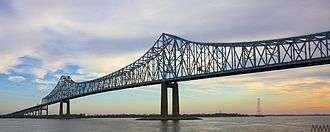
Chester is served by two interstate highways: Interstate 95 and Interstate 476, which meet in nearby Crum Lynne. I-95 was built in the 1960s and originally terminated just north of the Chester/Eddystone line at the present-day I-95/I-476 junction. It was extended north in the 1970s, with the section around Philadelphia International Airport being completed in 1985. Three exits on I-95 allow access to Highland Avenue, Kerlin Street, and Edgmont Avenue/Avenue of the States (Rts. 320 & 352).
Two federal highway routes, U.S. Route 13 and U.S. Route 322, also run through Chester. US 13 enters Chester from Trainer on W. 4th Street, becomes part of Highland Avenue between W. 4th Street and W. 9th Street, and then continues on 9th Street to Morton Avenue. US 13 follows Morton Avenue in the city's Sun Village section until it crosses Ridley Creek and becomes Chester Pike in Eddystone.
US 322 enters Chester from the northeast, merges with I-95 briefly and crosses the Delaware River over the Commodore Barry Bridge. Prior to the bridge's opening in 1974, US 322 would cross the Delaware River on the Chester-Bridgeport Ferry, via Flower Street, causing major backups because of limited space on the ferries. With the expansion of State Rt. 291 and the redevelopment of the Chester Waterfront, both the Delaware River Port Authority and PennDOT built a pair of entrance (westbound) and exit (eastbound) ramps to PA Rt. 291, providing direct access to the waterfront without using local streets. The ramps were built between 2007 and 2010 and were opened in 2011.[65]
Plans for reconstruction of US 322 and the merge with I-95 are underway.[66] The road currently requires traffic to merge onto I-95 in the left lane and requires changing lanes three times to the Commodore Barry Bridge exit ramp in less than a mile.
A $16.6 million project to fix up eight I-95 bridges will begin March 2017 and is expected to be finished in November 2018. Improvements to Chestnut Street and Morton Avenue are also included in the project.[67]
Public transportation
Public bus transportation in Chester is provided by the Southeastern Pennsylvania Transportation Authority (SEPTA), which acquired the former Suburban Philadelphia Transit Authority (aka "Red Arrow" Lines) in 1968. Seven bus routes (Routes 37, 109, 113, 114, 117, 118, and 119) serve the city, with the Chester Transportation Center as the hub.
The city is also served by the SEPTA Wilmington/Newark Line commuter rail service. The Chester Transportation Center and Highland Avenue stations are the two SEPTA train stations in Chester. The Lamokin Street station was run as a flagstop station until it was closed and demolished in 2003 due to low usage.
The Chester Transportation Center was both a commuter and intercity stop on the former Pennsylvania Railroad's New York City–Washington, D.C. route. The Chester Transportation Center was bypassed when Amtrak took over intercity rail passenger services in 1971, with the exception from April 30, 1978, to October 29, 1983, when the Chesapeake stopped once daily in each direction between Philadelphia and Washington, D.C..
Education
In 1995, the city's schools ranked last among the state's 501 districts, leading Pennsylvania education officials in 2001 to hire the for-profit Edison Schools to run the local school district for three years.[44]
Primary and secondary schools
Public schools
The Chester-Upland School District serves the city, along with nearby Chester Township and the borough of Upland.
Parochial schools
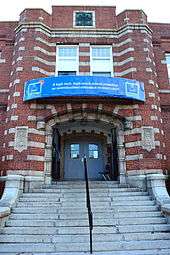
Drexel Neumann Academy, of the Roman Catholic Archdiocese of Philadelphia, is Chester's only parochial school. It is run by the Saint Katharine Drexel Roman Catholic Church which was established in 1993 by the Archdiocese of Philadelphia with the consolidation of all Roman Catholic parishes in the city.[68]
Resurrection of Our Lord School in Chester closed in 1993.[69] St. James High School for Boys closed its doors in 1993 due to low enrollment.
Charter schools
Chester Charter Scholars Academy began in 2008 as a small public-private partnership between The Chester Fund for Education and the Arts and the Chester-Upland school district. The school was originally called the Chester Upland School for the Arts (CUSA) and operated until 2011 when significant staff reduction occurred due to state funding cuts.[70] In 2012, a charter school application was accepted and the school operated in Aston until September 2017 when a $30 million campus was built on Highland Ave.[71]
Chester Community Charter School is a charter school established in 1998 that serves over 4,000 students in grades K-8.[72][73] The school operates four campuses, the Upland campus at 1100 Main Street in Upland, the Aston campus at 200 Commerce Drive in Aston, the East Campus at 302 East 5th Street and the West Campus at 2730 Bethel Road in Chester Township.[74]
Widener Partnership Charter School was first launched in 2006, and is located across from the main campus of Widener University. It has been operating for eight years, and has 400 enrolled students from kindergarten to eighth grade. Widener University provides support to the charter school including educating staff, providing work to graduate students, and use of the university facilities. The school also has a number of outside partners that include 21st Century Learning Communities, Andrew Hicks Foundation, Big Brothers Big Sisters, Big Friends, Chester Education Foundation, Earth Force, Exelon Foundation, Incredible Years, PECO, and Soccer for Success.[75] The Widener Partnership Charter School also has recently added a new $4.6 million wing of the school at 1450 Edgmont Ave. This new edition includes a science learning center, an extension of the library, a gymnasium, eight classrooms and eight offices.[76]
Colleges and universities
Widener University is a private, coeducational university located in Chester. Its main campus sits on 108 acres (0.44 km2). The university has three other campuses: two in Pennsylvania (Harrisburg and Exton) and one in Wilmington, Delaware.
Founded as The Bullock School for Boys in 1821, the school was established in Wilmington, Delaware. It became The Alsop School for Boys from 1846 to 1853, and then Hyatt's Select School for Boys from 1853 to 1859. Military instruction was introduced in 1858, and in 1859, the school changed its name to Delaware Military Academy. It moved to Chester in 1862 and became Pennsylvania Military Academy. It was known as Pennsylvania Military College after 1892 and adopted the Widener name in 1972.
About 3,300 undergraduates and 3,300 graduate students attend Widener in eight degree-granting schools. The university offers associates, bachelors, masters, and doctoral degrees in areas ranging from traditional liberal arts to professional programs. The Carnegie Foundation classifies Widener as a Doctoral/Research University and a Community Engagement Institution. Widener was ranked #181 in the National Universities category by US News & World Report for 2012.[77]
Crozer Theological Seminary was a multi-denominational religious institution built in 1858 by the wealthy industrialist John Price Crozer. Its most famous student was Martin Luther King, who graduated in 1951 with a Bachelor of Divinity degree.[78]
In 1970, the school was moved to Rochester, New York in a merger that formed the Colgate Rochester Crozer Divinity School.[79] The Old Main Building of the Crozer Theological Seminary was added to the National Register of Historical Places in 1973.[80] The seminary grounds are part of the Crozer Arboretum and the Old Main building is part of the Crozer-Chester Medical Center.
Sleeper's College was a vocational school founded in 1910 for "office and commercial training".[81]
Public Safety
Crime
According to a report in 2020 by NeighborhoodScout, Chester ranked 20th on a list of the "Top 100 Most Dangerous Cities in the U.S.".[82] NeighborhoodScout says one's chance of becoming a victim of either violent or property crime in Chester is one in 21, and that "Within Pennsylvania, more than 99% of the communities have a lower crime rate than Chester."[83]
Sports
Horse racing
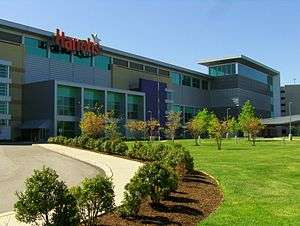
With the construction of Harrah's Philadelphia, the city received a series of horse races that were once held at the Brandywine Raceway and the now-defunct Liberty Bell Park Racetrack. The racino opened on January 22, 2008, and features a specially constructed bridge that enables the midpoint of races, contested at one mile, to take place over the Delaware River.
Soccer
| Club | Sport | League | Venue | Established | Championships |
|---|---|---|---|---|---|
| Philadelphia Union | Soccer | MLS | Subaru Park | 2010 |

Chester is the home of the Major League Soccer Philadelphia Union franchise, which plays its home games at Subaru Park, a soccer-specific stadium at the base of the Commodore Barry Bridge. Located on the Delaware River, the stadium is part of a larger development called Rivertown. Financing for the Rivertown development was announced in early 2008 by Governor Ed Rendell and Pennsylvania Senate Majority Leader Dominic Pileggi, with $25 million going to the construction of Subaru Park, and an additional $7 million towards a two-phase project composing of 186 townhouses, 25 apartments, 335,000 square feet (31,100 m2) of office space, a 200,000-square-foot (19,000 m2) convention center, more than 20,000 square feet (1,900 m2) of retail space, and a parking structure to house 1,350 cars. In phase two, another 200 apartments will be built, along with 100,000 square feet (9,300 m2) of office space and 22,000 square feet (2,000 m2) of retail space.[84]
Religion
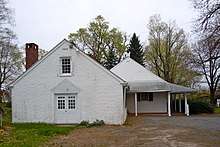
Chester has several churches of historical importance:
- Asbury AME Church - Founded in 1845, it is the second oldest African Methodist Episcopal Church in Chester behind the Union African Methodist Church built in 1832
- Calvary Baptist Church - A Baptist church founded in 1879. Martin Luther King Jr. attended Calvary Baptist when he was a student at Crozer Theological Seminary from 1948 to 1951
- Chester Friends Meetinghouse - The first Quaker meetinghouse was built in 1693 and William Penn was known to speak there
- St. Paul's Church and Old Burial Ground - An Episcopal church originally built in 1702. In 1859, a new church was built on Third Street. In 1900, the current St. Paul's Church was built at 9th and Madison Street. The Old Burial Ground contains the remains of John Morton, signer of the Declaration of Independence; David Lloyd, Chief Justice of the Pennsylvania Colony and Major William Anderson, officer in the Continental Army and U.S. Congressman
- Third Presbyterian Church - A Presbyterian church founded in 1872. It was the location of the first summer bible school in 1912.[85]
St. Katharine Drexel Church is the only Roman Catholic parish remaining in Chester. It is part of the Roman Catholic Archdiocese of Philadelphia and is the result of the conglomeration of six Chester parishes in 1993.[86]
Notable people
Points of interest
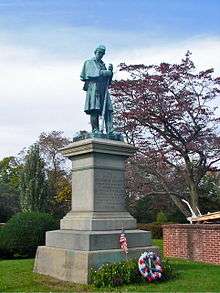
- Asbury AME Church
- 1724 Chester Courthouse
- Calvary Baptist Church
- Chester Friends Meetinghouse
- Chester Rural Cemetery
- Chester Waterside Station of the Philadelphia Electric Company
- Crozer Arboretum
- Crozer Theological Seminary
- Delaware County National Bank
- Harrah's Philadelphia Casino & Racetrack
- Madison Street Methodist Episcopal Church
- Old Main and Chemistry Building
- St. Paul's Church and Old Burial Ground
- Subaru Park
- Third Presbyterian Church
- Widener University
- William Penn Landing Site
Notes
- "2019 U.S. Gazetteer Files". United States Census Bureau. Retrieved July 28, 2020.
- "Population and Housing Unit Estimates". United States Census Bureau. May 24, 2020. Retrieved May 27, 2020.
- "PHMC Historical Markers Search" (Searchable database). Pennsylvania Historical and Museum Commission. Commonwealth of Pennsylvania. Retrieved 2015-02-11.
- "Geographic Identifiers: 2010 Demographic Profile Data (G001): Chester city, Pennsylvania". U.S. Census Bureau, American Factfinder. Archived from the original on February 13, 2020. Retrieved December 31, 2015.
- "History of Chester". www.chestercity.com. Retrieved 26 January 2018.
- Ashmead 1884, p. 328.
- Ferris, Benjamin (1846). A History of the Original Settlements on the Delaware. Wilmington: Wilson & Healde. p. 135. Retrieved 22 June 2017.
- Narratives of Early Pennsylvania, West New Jersey and Delaware 1630–1707, ed. Albert Cook Myers. New York: Charles Scribner's Sons (1912) https://www.questia.com/PM.qst?a=o&d=6006508
- Ashmead 1883, p. 2.
- Ashmead 1884, p. 20.
- "Lancaster County". Pennsylvania State Archives. Archived from the original on October 24, 2007. Retrieved April 20, 2018.
- "Chester County". Pennsylvania State Archives. Archived from the original on July 4, 2007. Retrieved April 20, 2018.
- Martin 1877, p. 21.
- Ashmead 1883, p. 30.
- Martin 1877, pp. 174-179.
- "Delaware County". Pennsylvania State Archives. Archived from the original on June 30, 2007. Retrieved April 20, 2018.
- Ashmead 1884, pp. 332-333.
- Ashmead 1883, p. 320.
- Ashmead 1883, p. 321.
- Ashmead 1883, p. 210.
- Mayberry, Jodine. "Media, Pennsylvania". www.philadelphiaencyclopedia.org. Retrieved 5 June 2017.
- Ashmead 1884, p. 333.
- Smith 1918, p. 38.
- "History of Economic Development in Chester". www.blogs.swarthmore.edu. Retrieved 19 April 2018.
- Mele 2017, p. 17.
- Trotter, Joe William (1997). African Americans in Pennsylvania. University Park, Pennsylvania: The Pennsylvania Historical and Museum Collection. p. 256. ISBN 0-271-01686-8. Retrieved 3 June 2018.
- Mele 2017, pp. 30-32.
- Mele 2017, p. 19.
- Mele 2017, p. 27.
- "Ford Motor Company". www.oldchesterpa.com. Retrieved 19 April 2018.
- Mele 2017, p. 39.
- "Chester, A City Working on a New Narrative". Grapple. Keystone Crossroads. 2016-09-27. Retrieved November 17, 2016.
- McLarnon, John M. (2002). ""Old Scratchhead" Reconsidered: George Raymond & Civil Rights in Chester, Pennsylvania". Pennsylvania History. 69 (3): 318–326. Retrieved 27 October 2018.
- Mele 2017, p. 82.
- Mele 2017, p. 94.
- "African American residents of Chester, PA, demonstrate to end de facto segregation in public schools, 1963-1966". www.nvdatabase.swarthmore.edu. Retrieved 26 October 2018.
- "RIOTS MAR PEACE IN CHESTER, PA.; Negro Protests Continue - School Policy at Issue". The New York Times. 1964-04-26. Retrieved 13 July 2018.
- Mele 2017, p. 95.
- "Chester NAACP Scrapbook 1963-1964". www.digitalwolfgram.widener.edu. Retrieved 20 October 2018.
- Stranahan, Susan Q. "Beyond the Flames". www.inquirer.philly.com. Archived from the original on 3 July 2018. Retrieved 2 July 2018.
- "Wade (ABM) Chester, PA". www.cumulis.epa.gov. Retrieved 2 July 2018.
- Blumgart, Jake. "Chester, Pennsylvania". www.philadelphiaencyclopedia.org. Retrieved 20 April 2018.
- Rigell, Laura. "Chester residents blockade Westinghouse incinerator, United States, 1992-1994". www.nvdatabase.swarthmore.edu. Retrieved 19 May 2018.
- George Sheridan (2003-01-26). "Edison in Chester Upland". Archived from the original on 2005-05-21.
- Cory, Jim (2001-12-07). "Industrial Grandeur, PriceDraw First Tenant". Philadelphia Business Journal.
- "National Register Information System". National Register of Historic Places. National Park Service. July 9, 2010.
- "City of Chester Mayor Butler". City of Chester. Archived from the original on 2009-05-31. Retrieved 2009-07-13.
- Sullivan, Vince (May 20, 2015). "Primary Election 2015: Kirkland defeats Linder, gets Democratic nod for Chester mayor". Retrieved 2016-11-09.
- Parks, Jessica (May 20, 2015). "Kirkland leads in Chester mayor race". Retrieved 2016-11-09.
- "Home". www.chestercity.com. Retrieved 2016-11-09.
- McCabe (25 May 2015). "Colwyn: Can this town be saved?". Philadelphia Daily News. Retrieved 26 May 2015.
- Martens, Frederick T. (2015). We'll Make You an Offer You Can't Refuse: A Primer on the Investigation of Public Corruption. Complex Litigation Sciences. ISBN 978-1-78301-750-8. Retrieved 22 June 2018.
- McLarnon, John Morrison (2003). Ruling Suburbia: John J. McClure and the Republican Machine in Delaware County. Newark, Delaware: University of Delaware Press. p. 11. ISBN 0-87413-814-0. Retrieved 23 June 2018.
- "M'CLURE WITH 70 GUILTY TO RUM CASE; State Senator Gets 18 Months as Head of Pennsylvania Protection Ring. HE IS RELEASED ON BOND Judge Tells Jury that "Might Forces" Backed Defendants -- Trial Lasted Eight Weeks". The New York Times. 1933-11-25. Retrieved 28 June 2018.
- "McClure's Conviction in Dry Era Expose Rises To Confront Him in Senate Attack". www.news.google.com. Retrieved 28 June 2018.
- Beers, Paul B. (1980). Pennsylvania Politics Today and Yesterday: The Terrible Accommodation. University Park, Pennsylvania: Pennsylvania State University Press. p. 139. ISBN 0-271-00238-7. Retrieved 28 July 2018.
- Decourcy Hinds, Michel (January 5, 1992). "Pennsylvania City Hopes It's Bouncing Back From the Bottom". The New York Times. Retrieved 9 May 2018.
- Decourcy Hinds, Michael (1992-01-05). "Pennsylvania City Hopes It's Bouncing Back From the Bottom". The New York Times. Retrieved 10 May 2018.
- "PRISM Climate Group, Oregon State University". Retrieved 13 August 2019.
- "Census of Population and Housing". U.S. Census Bureau. Retrieved 11 December 2013.
- "U.S. Census website". United States Census Bureau. Retrieved 2008-01-31.
- "Incorporated Places and Minor Civil Divisions Datasets: Subcounty Resident Population Estimates: April 1, 2010 to July 1, 2012". Population Estimates. U.S. Census Bureau. Archived from the original on 11 June 2013. Retrieved 11 December 2013.
- "Profile of General Population and Housing Characteristics: 2010 Census Summary File 1 (DP-1): Chester city, Pennsylvania". U.S. Census Bureau, American Factfinder. Archived from the original on February 13, 2020. Retrieved December 31, 2015.
- "Selected Economic Characteristics: 2010-2014 American Community Survey 5-Year Estimates (DP03): Chester city, Pennsylvania". U.S. Census Bureau, American Factfinder. Archived from the original on February 13, 2020. Retrieved December 31, 2015.
- "US 322". www.pahighways.com. Retrieved 20 March 2018.
- "Section CSC - 322 Conchester Highway". www.us322conchester.com. Retrieved 8 February 2018.
- FOX. "Construction to start on 8 I-95 bridges in Chester City". WTXF. Archived from the original on 2017-02-28. Retrieved 2017-02-28.
- "Drexel Neumann Academy". www.drexelneumannacademy.net. Retrieved 28 January 2018.
- "Our Parish School". Holy Saviour Parish. 2011-07-26. Archived from the original on 2011-07-26. Retrieved 2020-05-03.
- "History - CCSA". www.chestercharterschoolforthearts.org. Retrieved 27 January 2018.
- Boccella, Kathy. "New Chester Charter School for the Arts is called a beacon". www.philly.com. Retrieved 27 January 2018.
- Public school review data sheet
- About Us Archived June 21, 2010, at the Wayback Machine page from the school website
- "Contact Us | About". chestercommunitycharter.org. Archived from the original on 28 January 2018. Retrieved 27 January 2018.
- "University Partnership". widenerpartnershipcharterschool.org. 24 October 2013. Retrieved 23 October 2017.
- "Widener University - Widener Partnership Charter School Unveils New Wing". www.widener.edu. Archived from the original on 24 October 2017. Retrieved 23 October 2017.
- USNews.com: America's Best Colleges 2012: National Universities Rankings
- King, Martin Luther; Carson, Clayborne (1998), The autobiography of Martin Luther King, Jr., New York, New York: Warner Books, p. 62, OCLC 39399036, retrieved 2009-10-06
- Dugan, George (1970-05-17), "BAPTIST SEMINARY PLANS TO MERGE; Crozer Theological to Join With School in Rochester", The New York Times, p. 36, ISSN 0362-4331, retrieved 2009-10-06
- "National Historic Landmarks & National Register of Historic Places in Pennsylvania" (Searchable database). CRGIS: Cultural Resources Geographic Information System. Note: This includes Pennsylvania Register of Historic Sites and Landmarks (June 1972). "National Register of Historic Places Inventory Nomination Form: Old Main" (PDF). Retrieved 2012-01-06.
- "Sleeper's College". www.oldchesterpa.com. Retrieved 28 January 2018.
- "NeighborhoodScout's Most Dangerous Cities – 2020". neighborhoodscout.com. Retrieved 25 April 2020.
- "Chester, PA Crime Rates". neighborhoodscout.com. Retrieved 25 April 2020.
- "Major hurdle cleared for Philly expansion". MLSnet.com. Archived from the original on November 9, 2007. Retrieved January 31, 2008.
- Chester. Charleston, South Carolina: Arcadia Publishing. 2008. p. 27. ISBN 978-0-7385-6348-0. Retrieved 31 December 2017.
- Mengers, Patti (2013-06-02). "Philadelphia Archdiocese announcing church parish closings". Mainline Times. Mainline Media News. Retrieved 2020-05-03.
References
- Ashmead, Henry Graham (1883). Historical Sketch of Chester, on Delaware. Republican Steam Printing House.CS1 maint: ref=harv (link)
- Ashmead, Henry Graham (1884). History of Delaware County, Pennsylvania. L.H. Everts & Co.CS1 maint: ref=harv (link)
- Martin, John Hill (1877). Chester (and Its Vicinity,) Delaware County, in Pennsylvania. Wm. H. Pile & Sons.CS1 maint: ref=harv (link)
- Mele, Christopher (2017). Race and the Politics of Deception: The Making of an American City. New York University Press. ISBN 978-1-4798-6609-0.CS1 maint: ref=harv (link)
- Smith, H.V. (1914). Chester and Vicinity. H. V. Smith.CS1 maint: ref=harv (link)
Further reading
- Blumgart, Jake. "Chester, Pennsylvania". The Encyclopedia of Greater Philadelphia. Mid-Atlantic Regional Center for the Humanities (MARCH) at Rutgers-Camden. Retrieved 10 February 2016.
- Johnson, Amandus The Swedes on the Delaware (International Printing Company, Philadelphia. 1927)
- Weslager, C. A. New Sweden on the Delaware 1638–1655 (The Middle Atlantic Press, Wilmington. 1988)
- Sigmond, Carl E. (29 August 2011). "African American residents of Chester, PA, demonstrate to end de facto segregation in public schools, 1963-1966". Retrieved 13 July 2018.
External links
| Wikimedia Commons has media related to Chester, Pennsylvania. |
- City of Chester official website
- J. Lewis Crozer Library - part of the Delaware County Library System
- OldChesterPA.com - Chester History
- . Encyclopædia Britannica. 6 (11th ed.). 1911. p. 109.
- Widener University Wolfgram Memorial Library Digital Collections - History of Chester
| Preceded by none |
County seat of Chester County 1682–1786 |
Succeeded by West Chester |
| Preceded by none |
County seat of Delaware County 1789–1851 |
Succeeded by Media |

